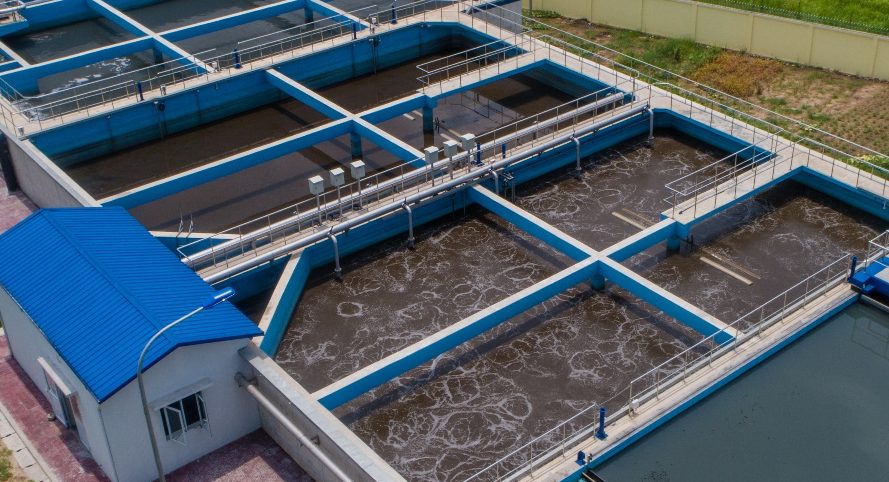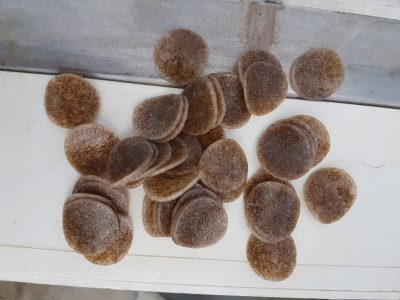ANAEROBIC TREATMENT
UASB – UPFLOW ANAEROBIC SLUDGE BLANKET
Microbial populations (mostly bacteria) will decompose into the organic matter in anaerobic condition (absence of oxygen) with the end product is a gas mixture consists of CH4, CO2, N2, H2S, CO, etc., in which methane CH4 is the main component.
UASB includes 2 main zones: digestion zone and three-phase separation zone. Wastewater distributed from the tank bottom will flow through this anaerobic sludge layer in digestion zone, at which organic substances will be degraded by the anaerobic microorganisms. To keep the sludge layer in suspension and to create a favorable condition for granular sludge forming, up-flow velocity in UASB will be maintained in the range between 0.6 – 0.9m/h.
UASB is often applied in industrial wastewater treatment with high COD concentration. Koastal Eco had successfully designed and operated many UASBs for various types of industrial wastewater with the flowrate up to 5,000 m3/day and COD loading up to 15,000 kgCOD/day.

UASB in food processing wastewater treatment
CSTR - ANAEROBIC CONTINUOUSLY STIRRED TANK REACTOR
CSTR is an anaerobic Continuously Stirred Tank Reactor followed by a degasified tank to dismiss residual biogas, and a clarifier to separate treated effluent and biomass. This tank is a good choice for anaerobic feeds with high suspended solids and high COD concentration, which can create flocculated sludge between biomass and suspended solids through evenly mixing inside the reactor. Due to this flocculation mechanism, biomass and undigested suspended solids will be collected at the bottom of the downstream clarifier and returned to CSTR to maintain necessary microorganism quantity and further digest the remaining solids. With the large amount of biogas produced in CSTR, a gas holder is often provided with CSTR to store and supply fuel gas for boiler or generator, which could save energy consuming for the investors.
Koastal Eco constructed CSTR with the capacity of 2,000 m3/day corresponds with COD loading of 16,000 kgCOD/day or SS loading of 2,200 kgSS/day.
.jpg)
CSTR process in wastewater treatment of food processing
ANOXIC AND AEROBIC TREATMENT
ANOXIC TANK – BIOLOGICAL NITROGEN REMOVAL REACTOR
Microorganisms in the anoxic tank have the denitrifying capability by converting nitrate into free nitrogen. This additional nitrate amount is provided by the aeration tank (located before or after an anoxic tank) through an internal recirculation pump (if the anoxic tank is put before the aerobic tank). The wastewater after denitrified in anoxic tank will be treated in the aeration tank by oxidized and nitrified organic substances.
Koastal Eco had applied anoxic tank in various activated sludge systems for combining biological organic substances removal and nitrogen removal with flowrate up to 55,000 m3/day and nitrogen loading up to 1,500 kgTN/day

Anoxic tank in an industrial wastewater treatment plant
CONVENTIONAL ACTIVATED SLUDGE PROCESS – AEROTANK
In continuously air supplying condition, aerobic heterotrophic microorganisms utilize organic compounds as an energy and carbon source to synthesize new cells and form simple inorganic compounds like CO2 and H2O. In contrast, autotrophic microorganisms use carbon dioxide as a carbon source and oxidize inorganic compounds for energy.
Aerotank is the most popular biological treatment tank in the world, and very suitable for treatment of wastewater containing degradable organic matter. The project scale that Koastal Eco applied for aerotank was up to 55,000m3/day and for the flowrate up to 5,040 kgBOD/day for BOD loading.

Aeration tank in Centralized Wastewater Treatment Plant of Industrial Park
OD - OXIDATION DITCH
Oxidation ditch is developed based on extended aeration process. Low speed vertical shaft aerator or brush rotor is used to provide the necessary oxygen to support biodegradation process, while also keep the biomass in suspension by driving the mixed liquor across the entire looped channel. Thanks to closed loop shape, the wastewater is highly circulated around the channel (> 20 times) without using any recirculation pump. Activated sludge microorganisms efficiently break down the organic compounds and nitrogen containing wastes through alternate anoxic zone and aerobic zone. This advantage will help to control the COD effluent and nitrogen concentration with very low operation cost.
Koastal Eco had applied oxidation ditch for both urban and industrial wastewater with the capacity up to 20,000 m3/day and nitrogen loading up to 1,200 kgTN/day.
.jpg)
Oxidation Ditch in Urban Sewage Treatment Plant
SBR - SEQUENCING BATCH REACTOR
The sequencing batch reactor (SBR) process is a sequential suspended growth (activated sludge) process in which all major steps occur in the same tank in sequential order without utilizing a separated clarifier. This advantage of SBR could result in a competitive investment cost for high capacity projects.
SBRs can be designed and operated to enhance removal of nitrogen, phosphorus, and ammonia, in addition to removing TSS and BOD thanks to customizing anaerobic, anoxic, aerobic, and settling phases in a cycle.
With flexibility in cycle time and number of tanks, SBR is often applied by Koastal Eco in industrial zone wastewater treatment plants with flowrate up to 5,000 m3/day.

SBR in Industrial Zone Wastewater Treatment Plant
IFAS – INTEGRATED FIXED-FILM ACTIVATED SLUDGE
IFAS is a process that consists of activated sludge (suspended growth) and carrier-fixed biofilms (attached growth) together in the same reaction tank. Thanks to the additional bio carrier in activated sludge reactors (for both anoxic tank and aeration tank), additional bacteria population growth appears on the carrier surface, then increases the sludge retention time. Sludge layer in bio carriers with anoxic microorganism layer inside and aerobic microorganism layer outside will help the process of simultaneously treating COD and nitrogen pollutants. With a higher microbial density than conventional activated sludge systems, IFAS process is suitable for application in:
-
Designing a new plant with small footprint
-
Increasing existing plant capacity
-
Improving treatment performance of an existing plant.
Koastal Eco had applied IFAS process for numerous projects, both newly built and renovation. IFAS’s capacity that Koastal Eco constructed was up to 55,000 m3/day corresponds with a COD load of 22,000 kgCOD/day and a nitrogen load of 1,500 kgSS/day.


IFAS in Industrial Zone Centralized Wastewater Treatment Plant
MBBR – MOVING BED BIOFILM REACTOR
Essentially, MBBR has the same structure as IFAS mentioned above, which includes an anoxic tank and an aerobic tank followed by a clarifier. However, the treatment principle of this tank is developed based on the biofilter process utilizing attached growth microorganisms, while IFAS utilizes both suspended growth microorganisms and attached growth microorganisms. Therefore, the clarifier in this process is used only for separating old and residual sludge without needing to be recirculated to the MBBR reactor.
This innovative technology is designed with a unique hydraulic regime to ensure the moving of carriers is distributed evenly around the reactor.
Together with the advantages of the IFAS process, MBBR has further benefits as below:
-
Compact, minimal footprint
-
Can stand high loading variation
-
Low sludge production
-
Stable and strong performance
MBR – MEMBRANE BIO REACTOR
MBR is a reactor combining an activated sludge process with an ultrafiltration process (please see further in Advanced treatment process and Wastewater recycling process) to produce the high-quality treated effluent. With this process, MLSS in the MBR tank can be maintained up to 15,000 mg/l. MBR systems, which could be designed for both urban and industrial wastewater treatments, offer several operational and economic advantages compared to conventional wastewater treatment plants such as:
Eliminate the need for secondary clarifiers and tertiary treatment,
Increase performance with a smaller footprint
Treated effluent can be reused for many purposes: irrigation, toilet flushing, car washing, road cleaning, etc.
The picture below is an MBR plant that Koastal Eco implemented for an industrial wastewater treatment plant with the flowrate of 600 m3/day corresponds with a COD load of 180 kgCOD/day.

MBR system in Industrial Wastewater Treatment Plant
BNR - BIOLOGICAL NUTRIENT REMOVAL PROCESS
To simultaneously remove BOD, nitrogen, and phosphorous by biological method, general specification of this integrated process is the alternating change in treatment processes such as anaerobic, anoxic, aerobic treatment depending on the treated effluent requirement. Thanks to the biological treatment method, we can save a significant amount of operation chemical cost in comparison with the phosphorous chemical treatment method.
This process is normally applied for the treatment of wastewater with both nitrogen and phosphorous removal demand. Koastal Eco applied this process with flowrate up to 2,500 m3/day corresponds with 2,500 kgN/day (nitrogen loading) and 87.5 kgP/day (phosphorous loading).

Bardenpho process in Rubber Wastewater Treatment Plant